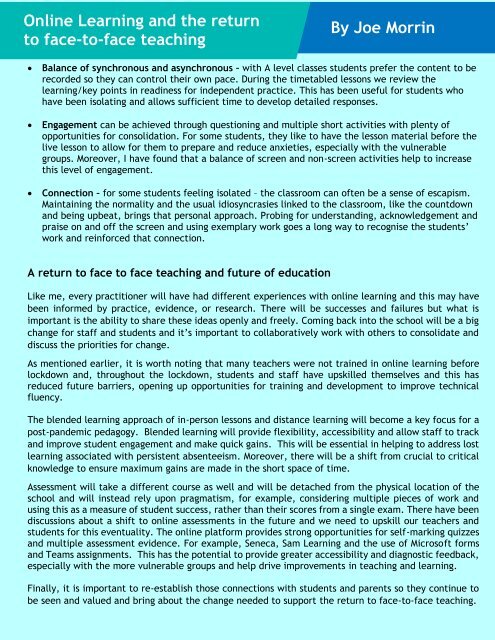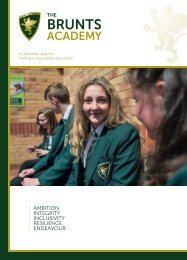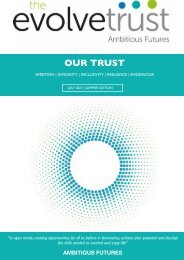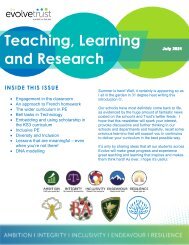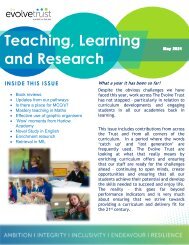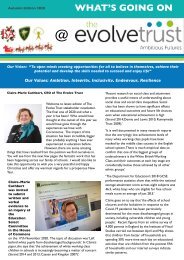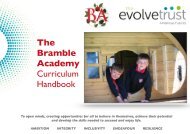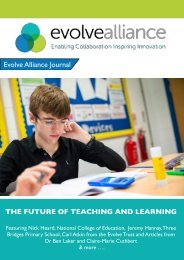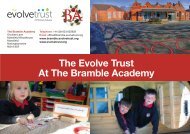Spring 1 2021 Teaching and Learning Newsletter
Teaching and learning newsletter - The Evolve Trust
Teaching and learning newsletter - The Evolve Trust
Create successful ePaper yourself
Turn your PDF publications into a flip-book with our unique Google optimized e-Paper software.
Online <strong>Learning</strong> <strong>and</strong> the return<br />
to face-to-face teaching<br />
By Joe Morrin<br />
• Balance of synchronous <strong>and</strong> asynchronous – with A level classes students prefer the content to be<br />
recorded so they can control their own pace. During the timetabled lessons we review the<br />
learning/key points in readiness for independent practice. This has been useful for students who<br />
have been isolating <strong>and</strong> allows sufficient time to develop detailed responses.<br />
• Engagement can be achieved through questioning <strong>and</strong> multiple short activities with plenty of<br />
opportunities for consolidation. For some students, they like to have the lesson material before the<br />
live lesson to allow for them to prepare <strong>and</strong> reduce anxieties, especially with the vulnerable<br />
groups. Moreover, I have found that a balance of screen <strong>and</strong> non-screen activities help to increase<br />
this level of engagement.<br />
• Connection – for some students feeling isolated – the classroom can often be a sense of escapism.<br />
Maintaining the normality <strong>and</strong> the usual idiosyncrasies linked to the classroom, like the countdown<br />
<strong>and</strong> being upbeat, brings that personal approach. Probing for underst<strong>and</strong>ing, acknowledgement <strong>and</strong><br />
praise on <strong>and</strong> off the screen <strong>and</strong> using exemplary work goes a long way to recognise the students’<br />
work <strong>and</strong> reinforced that connection.<br />
A return to face to face teaching <strong>and</strong> future of education<br />
Like me, every practitioner will have had different experiences with online learning <strong>and</strong> this may have<br />
been informed by practice, evidence, or research. There will be successes <strong>and</strong> failures but what is<br />
important is the ability to share these ideas openly <strong>and</strong> freely. Coming back into the school will be a big<br />
change for staff <strong>and</strong> students <strong>and</strong> it’s important to collaboratively work with others to consolidate <strong>and</strong><br />
discuss the priorities for change.<br />
As mentioned earlier, it is worth noting that many teachers were not trained in online learning before<br />
lockdown <strong>and</strong>, throughout the lockdown, students <strong>and</strong> staff have upskilled themselves <strong>and</strong> this has<br />
reduced future barriers, opening up opportunities for training <strong>and</strong> development to improve technical<br />
fluency.<br />
The blended learning approach of in-person lessons <strong>and</strong> distance learning will become a key focus for a<br />
post-p<strong>and</strong>emic pedagogy. Blended learning will provide flexibility, accessibility <strong>and</strong> allow staff to track<br />
<strong>and</strong> improve student engagement <strong>and</strong> make quick gains. This will be essential in helping to address lost<br />
learning associated with persistent absenteeism. Moreover, there will be a shift from crucial to critical<br />
knowledge to ensure maximum gains are made in the short space of time.<br />
Assessment will take a different course as well <strong>and</strong> will be detached from the physical location of the<br />
school <strong>and</strong> will instead rely upon pragmatism, for example, considering multiple pieces of work <strong>and</strong><br />
using this as a measure of student success, rather than their scores from a single exam. There have been<br />
discussions about a shift to online assessments in the future <strong>and</strong> we need to upskill our teachers <strong>and</strong><br />
students for this eventuality. The online platform provides strong opportunities for self-marking quizzes<br />
<strong>and</strong> multiple assessment evidence. For example, Seneca, Sam <strong>Learning</strong> <strong>and</strong> the use of Microsoft forms<br />
<strong>and</strong> Teams assignments. This has the potential to provide greater accessibility <strong>and</strong> diagnostic feedback,<br />
especially with the more vulnerable groups <strong>and</strong> help drive improvements in teaching <strong>and</strong> learning.<br />
Finally, it is important to re-establish those connections with students <strong>and</strong> parents so they continue to<br />
be seen <strong>and</strong> valued <strong>and</strong> bring about the change needed to support the return to face-to-face teaching.


